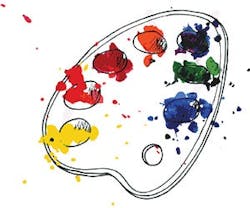Art+Design
It’s something we’ve known all along. With an abundance of recent neuroscience and psychological studies backing it up, we as interior designers, architects, and space dwellers recognize that the environments in which we live, work, play, and heal make a very real impact on how we feel. The colors, textures, light, aesthetics, and structure of our environments affect our emotional responses, decision-making, coping mechanisms, and productivity—both consciously and subconsciously.
Recent research has studied what people respond to visually to determine if there are underlying, universal preferences. Results show that people tend to favor certain color or style aesthetics. In fact, a 2015 study quoted in “The Fascinating Science of Aesthetics” in Fast Company revealed that people across the world generally liked and disliked many of the same things in artwork. Participants in all 10 countries studied preferred the color blue, likely reminding them of pleasant skies. Most surveyed for the project disliked abstract art, and favored curves over sharp, jagged lines.
Does this mean that successful design should become formulaic? No. It’s useful information to consider, but it doesn’t replace the need to understand how a particular space will be used and to make design decisions based on that understanding.
In healthcare, for instance, it is well established that a hospital or clinic’s spaces can be an important part of service perception. The experiential environment is not merely a backdrop for care delivery, it is an integral part of how a patient interprets quality. It’s the sum total of everything from the art on the walls to the wayfinding graphics, furniture design, and colors of the room. Such factors can reduce the perception of wait time, ease tension, increase comprehension, and foster better patient-staff relationships. Care providers can also benefit from good space design—a factor that can reduce the stress and burnout that plagues nearly every healthcare organization today.
At ASID, envisioning the workplace of the future isn’t just a theoretical discussion.
We’re walking the talk with the opening of our new national headquarters in Washington, D.C. Through an arduous yet inspiring exploratory and planning process, we’ve set our priorities for health and wellness, sustainability, resiliency, flexibility, social responsibility, and more to create an environment that is transforming not only the workspace, but also our organization as a whole. Considerations such as access to light, accommodation of a variety of work styles, visual connectedness, and transparency have all been brought into the planning, and we’re performing the pre- and post-occupancy studies that will demonstrate the results.
Additionally, our vital relationship with nature has been a foundational factor addressed through the a biophilia plan that will help reduce absenteeism, improve productivity, and enhance the overall work experience. Our goal within our new offices is to become a living laboratory that gathers real-time feedback and provides a continually improving, dynamic environment.
Beyond technology and functional planning, however, is the desire most of us feel to support creativity in tangible terms. We seek materials and products that not only make sense from a design perspective, but also feed our creative soul. We are committed to uniting art and space.
Without a doubt, art and interior design are inextricably linked. Interior design is, in itself, an art form, bringing beauty and functionality seamlessly together in residential and commercial spaces. As an example, it’s no mistake that interior design is closely connected to art schools such as the Savannah College of Art and Design.
As another example, forward-thinking industry partners such as Kabuni are also striving, as they say, “to shine a light on positive approaches to design and craftsmanship”—with a goal of improving the “experience of living.” Kabuni
promotes great design and the purchase of sustainable products by helping connect local artisans and manufacturers to the designers who wish to access them.
The opportunities truly are limitless and exciting for all of us. We can continually grow through the research and resources available to us, as our evolving ability to create sustainable, resilient, and wellness-promoting interiors is changing lives each and every day.
Sandy Gordon, FASID, LEED AP, is the chair of the Board of Directors for ASID and principal of SGI Interiors in Madison, Wisc. Learn more about ASID at www.asid.org.
